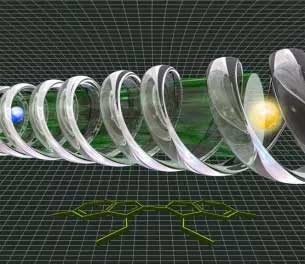| Jun 17, 2020 | |
Building better bridges for moving energy with DNA(Nanowerk News) Scientists have developed a new type of nanostructure that mimics certain natural light-harvesting systems. The nanostructure is an assembly of molecules that organize using instructions in the form of DNA templates to produce a structure that measures in nanometers. |
|
| The new nanostructures serve as a bridge to move energy generated by light-absorbing molecules to light-emitting molecules. The transfer has almost no energy loss (less than 1 percent). This means the bridge can carry energy over distances of hundreds of nanometers. | |
 |
|
| DNA and a new type of molecular aggregates act as a molecular bridge in artificial light-harvesting systems, connecting light-absorbing and light-emitting molecules. Experiments suggest almost no energy loss during the transfer. (Image: Hao Yan, Arizona State University) | |
| The research provides a new approach for transferring energy efficiently over very long nanowires. The new approach for the design of these energy transfer bridges has potential applications in photonic networks. Photonic networks transfer data as light. They are widely used in communications, information processing, and other applications. | |
| Designing and assembling artificial systems that harvest light in ways similar to natural photosynthesis pose significant challenges. These systems must absorb enough light to be an effective harvester and then must efficiently direct the energy derived from the light through the assembly. These systems also need careful control of their structures to precisely coordinate energy harvesting and transfer. | |
| Current artificial systems suffer from a variety of problems including inefficient energy transfer. Another problem is energy exchange between neighboring molecules (self-quenching) that competes with long range energy transfer. | |
| Natural photosynthetic systems pack multiple pigments in precise molecular arrangements using protein scaffolds to achieve efficient energy transfer while avoiding self-quenching. In artificial systems, the pigments are replaced by molecules called “dyes” that absorb light. | |
| Now, researchers have developed a new type of DNA-templated cyanine dye aggregate with the required strong inter-aggregate coupling that mimics natural systems’ light-harvesting functions. The dyes spontaneously assembled on the DNA scaffolds to form aggregate structures that direct energy transfer over distances of at least 32 nanometers. The DNA-templated dye aggregates formed a molecular bridge between light absorbing (donor) and light emitting (acceptor) molecules to build up an energy transfer system. | |
| The efficiency of aggregate assembly increased as the length of the DNA increased. This is an important finding since energy from the light absorbed by the donor must cross the entire bridge to the acceptor. Interestingly, the aggregate assembly has only a weak dependence on any specific DNA sequence. The overall energy transfer efficiency was approximately 60 percent. |
| Source: U.S. Department of Energy, Office of Science | |
|
Subscribe to a free copy of one of our daily Nanowerk Newsletter Email Digests with a compilation of all of the day's news. |
